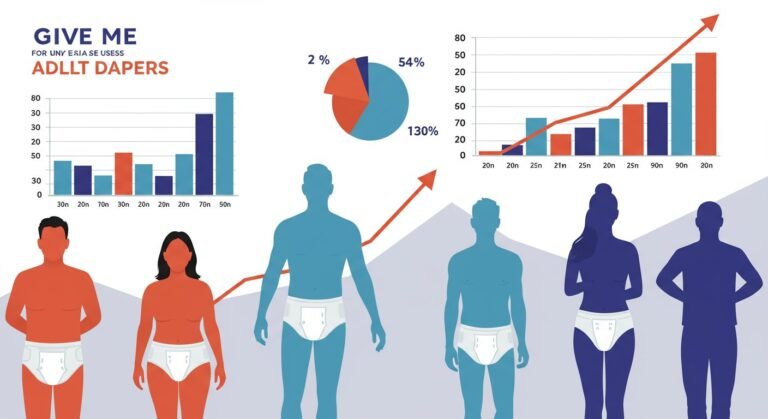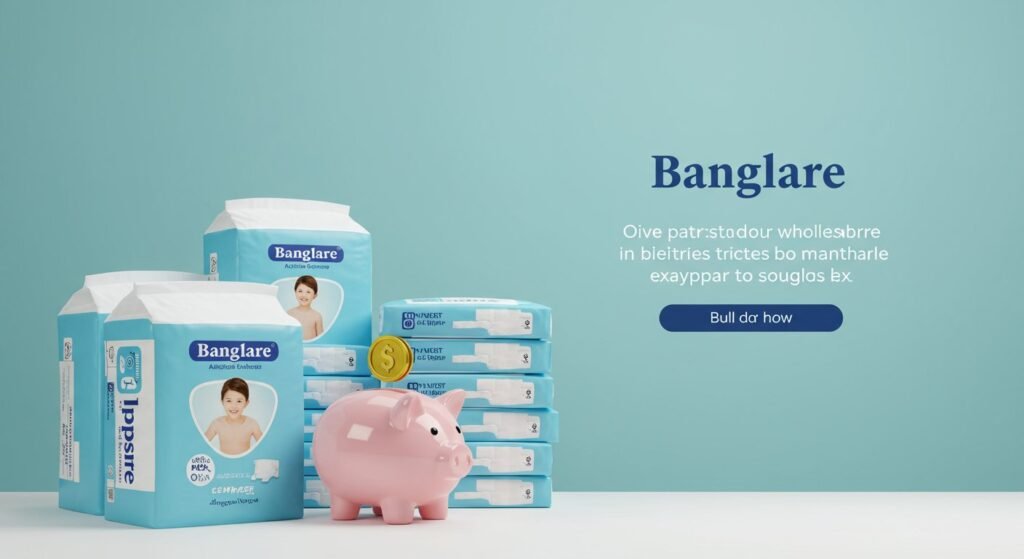Let’s talk about something that many people experience but few openly discuss: adult incontinence and the use of adult diapers. You might be surprised to learn just how common this situation is. Often shrouded in silence due to stigma, the reality is that millions of adults rely on incontinence products for various reasons, allowing them to live fuller, more active lives.
At Favourite Care, we understand the sensitivities surrounding bladder control and bowel control issues. Therefore, we believe in providing clear, compassionate information. This post aims to shed light on adult diaper usage, explore the statistics, discuss the reasons adults wear diapers, and offer practical advice on managing adult incontinence with dignity and comfort. Because understanding the prevalence is the first step towards normalization and finding the best solutions.
Understanding Adult Incontinence: More Common Than You Think
First things first, what exactly is adult incontinence? Simply put, it’s the involuntary loss of urine (urinary incontinence) or feces (fecal incontinence). It’s crucial to understand that incontinence isn’t a disease itself, but rather a symptom of an underlying medical condition, physical change, or circumstance.
Importantly, it affects people across different age groups, not just the elderly. While the likelihood increases with age, many younger adults experience incontinence too. This condition can range from occasional minor leaks to complete loss of bladder control or bowel control.
How Many Adults Actually Use Diapers? Unpacking the Statistics
Pinpointing the exact number of adults using diapers is challenging. Why? Because stigma often leads to underreporting. Many individuals feel embarrassed or hesitant to discuss their needs, even with healthcare providers. However, research and market data give us a clearer picture.
- Prevalence of Incontinence: Studies suggest that adult incontinence affects a significant portion of the population. Estimates vary globally, but it’s believed that hundreds of millions of adults worldwide experience some form of incontinence. For instance, some reports indicate that up to 1 in 3 women and 1 in 10 men may experience urinary incontinence at some point in their lives.
- Adult Diaper Usage Statistics: While not everyone with incontinence uses diapers, the market for adult diapers is substantial and growing. Market research reports often estimate the user base in the tens of millions globally. The percentage of adults with incontinence who use diapers depends on the severity of their condition, lifestyle, and awareness of available products.
- How Common is Adult Diaper Use? It’s more common than social silence suggests. Consider the sheer number of products available in stores and online – this reflects a significant demand. As populations age and awareness increases, the visibility and acceptance of adult diaper usage are slowly improving.
These adult diaper statistics highlight that if you or someone you care for uses these products, you are far from alone.
Why Do Adults Need Diapers? Exploring the Reasons
The reasons adults wear diapers are diverse and often linked to specific health challenges. Understanding the causes of adult incontinence helps foster empathy and identify appropriate management strategies. Here are some common factors:
Medical Conditions
Certain chronic illnesses significantly increase the risk of incontinence.
Diabetes: Can cause nerve damage (neuropathy) affecting bladder control.
Stroke: May damage nerves controlling the bladder and bowels.
Multiple Sclerosis (MS) & Parkinson’s Disease: These neurological disorders often interfere with nerve signals related to bladder and bowel function.
Dementia & Alzheimer’s Disease: Cognitive impairment can lead to forgetting to use the toilet or difficulty recognizing the body’s signals.
Neurological Disorders
Damage to the brain, spinal cord, or nerves can disrupt the complex signaling required for continence.
Spinal Cord Injuries: Can interrupt nerve pathways controlling bladder and bowel emptying.
Nerve Damage: Can result from injury, surgery, or conditions like diabetes.
Mobility Issues
Sometimes, the issue isn’t solely bladder or bowel function, but the physical ability to reach a toilet in time.
Severe Arthritis: Pain and stiffness can make movement difficult and slow.
Physical Disabilities: Conditions limiting mobility can necessitate incontinence products for convenience and hygiene.
Postpartum Incontinence
Childbirth can stretch and weaken pelvic floor muscles, leading to temporary or sometimes persistent urinary incontinence. This is a very common experience for women after delivery.
Post-Surgery
Certain surgeries can impact continence, particularly those involving the pelvic region.
Prostate Surgery: Removal or treatment of the prostate gland (prostate surgery) is a common cause of temporary or permanent urinary incontinence in men.
Bladder or Bowel Surgery: Procedures in these areas can affect normal function.
Age-Related Changes
As we age, muscles, including those in the pelvic floor and bladder, can naturally weaken, potentially leading to leaks or urgency.
Age and Adult Diaper Use: Is There a Typical Starting Point?
A common question is, what age do adults start using diapers? There’s no single answer. While the prevalence of conditions causing incontinence increases with age, adult diaper usage is determined by need, not a specific birthday.
Many people associate adult diapers solely with the elderly. However, young adults wearing diapers is a reality for those dealing with conditions like MS, spinal cord injuries, severe diabetes, or postpartum incontinence. Similarly, young women in diapers due to childbirth recovery or other medical reasons is not uncommon. The focus should always be on the underlying cause and ensuring the individual has the support and products they need, regardless of age.
Managing Adult Incontinence: Beyond Just Diapers
Using adult diapers is often a key part of managing adult incontinence, but it’s usually most effective when combined with other strategies. Here’s a look at a holistic approach:
Choosing the Right Product
This is fundamental. The market offers various options, and the best choice depends on individual needs. Consider:
Absorbency: Products range from light liners for minor leaks to maximum absorbency briefs for heavy incontinence. Choosing the right level prevents leaks and ensures comfort.
Leak Protection: Features like leg cuffs and waterproof backing are vital for preventing accidents.
Comfort and Fit: A good fit prevents leaks and chafing. Look for breathable materials, especially if you have sensitive skin. Favourite Care offers a range of options, including some of the best adult diapers for sensitive skin.
Type: Options include pull-up styles (like regular underwear), tab-style briefs (for easier changing, especially with mobility issues), pads, and guards.
Skincare is Crucial
Prolonged exposure to moisture can lead to skin irritation, rashes, and breakdown.
Cleanse Gently: Use mild, pH-balanced cleansers.
Dry Thoroughly: Pat skin dry; avoid rubbing.
Use Barrier Creams: Zinc oxide or petroleum-based barrier creams create a protective layer between the skin and moisture. This is essential for preventing diaper rash.
Lifestyle Adjustments
Simple changes in daily routine can significantly reduce the impact of incontinence on daily life.
Fluid Management:
Avoiding excessive caffeine, alcohol, and citrus-based drinks can reduce bladder irritation. Staying hydrated is still important, but it’s smart to time fluid intake—limiting liquids before bed, for example, can help minimize nighttime accidents.
Bladder Training:
This involves scheduled bathroom visits and gradually increasing the time between them to train the bladder for better control. It’s often paired with pelvic floor exercises for improved results.
Pelvic Floor Exercises (Kegels):
Strengthening pelvic floor muscles can improve bladder control, particularly for women experiencing postpartum incontinence or age-related weakness.
Dietary Considerations:
A fiber-rich diet can help prevent constipation, which is a common contributor to incontinence. Chronic straining during bowel movements weakens pelvic floor muscles over time.
Emotional Support and Counseling:
Living with incontinence can lead to anxiety, embarrassment, and depression. Speaking to a therapist or joining a support group can provide reassurance and community support.
Social Acceptance: Normalizing Adult Diaper Use
One of the most significant barriers to managing incontinence effectively is societal stigma. It’s time to normalize wearing diapers for adults of all ages.
The adult diaper trend is rising, not just due to an aging population, but also thanks to increased awareness, improved product design, and better education about health. For young adults wearing diapers, acceptance is growing, particularly for those managing chronic illnesses or recovering from medical procedures.
Jobs that require wearing diapers, such as long-haul drivers, astronauts, and certain security or emergency personnel, also show that diaper use can be a practical choice beyond medical need.
Fostering open conversations about adult incontinence can empower individuals and create a more supportive society. At Favourite Care, we believe everyone deserves to live with dignity—free from shame or discomfort.
Frequently Asked Questions (FAQ)
What percentage of adults use diapers?
It’s estimated that approximately 12–19% of adults worldwide experience incontinence, and while not all use diapers, millions rely on them regularly. Usage is more common among older adults, but younger populations are increasingly represented in this demographic due to rising awareness and medical needs.
How many adult diapers per day?
The number varies depending on the individual’s condition and severity. On average, most adults use between 3 to 6 diapers per day. Some may need more during illness or post-surgery recovery, while others may need fewer with light incontinence.
How many times can an adult pee in an adult diaper?
Adult diapers are designed to handle multiple voids, typically absorbing 2 to 4 urinations, depending on the brand, style, and absorbency level. However, it’s important to change them promptly to maintain skin health and comfort.
Why are adult diapers so popular?
Adult diapers have gained popularity due to a combination of factors:
-
Growing elderly population
-
Improved awareness and medical diagnosis
-
Advancements in discreet, comfortable design
-
Acceptance of conditions like postpartum incontinence and chronic illness
-
Jobs that require wearing diapers for long hours without breaks
This increase reflects not just medical necessity, but also lifestyle adaptability, especially for young women in diapers, new mothers, and individuals with physically demanding careers.
Contact Us – Favourite Care
At Favourite Care, we’re committed to helping people manage incontinence with dignity, comfort, and confidence. Whether you’re exploring options for yourself or a loved one, our expert team is here to guide you.
📞 Call Us: +91-8800775462
📧 Email: info@favouritecare.in
Let’s talk, because your comfort and peace of mind matter.




